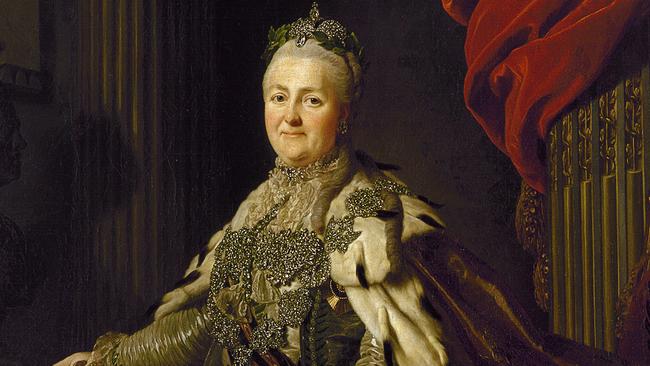Catherine the Great’s treasures inspired by private tragedy
Catherine II ruled Russia with an iron fist but perhaps her greatest legacy was the founding of the magnificent State Hermitage Museum.

Today in History
Don't miss out on the headlines from Today in History. Followed categories will be added to My News.
As Empress of Russia, Catherine II aggressively expanded her nation’s borders and reformed its health and education systems. Her extraordinary achievements saw her dubbed Catherine the Great.
But it’s just possible Catherine would prefer to be remembered for being what Ted Gott calls the founding “de facto director” of the magnificent State Hermitage Museum, located on the bank of the Neva River in St Petersburg in buildings which include the grand and ornate Winter Palace.
Dr Gott is one of the curators of the stunning blockbuster exhibition Masterpieces From The Hermitage: The Legacy Of Catherine The Great, on view at the National Gallery of Victoria until November 8. It is one of the largest collections to ever leave Catherine’s legacy.
Catherine was intellectual and discerning, Gott says. But it was her tragic private life that drove her to seek refuge in the arts. At 14 she was “imported” to Russia by the childless empress Elizabeth I to marry the dull-witted and sadistic Russian heir, Peter Fedorovich, 15.
Elizabeth gave Prussian-born Catherine no peace and no freedom, even snatching Catherine’s first two children at birth and raising them herself.
Catherine’s loveless marriage ended in 1762 when Peter, who had just become emperor on Elizabeth’s death, was strangled by the brother of Grigory Orlov, Catherine’s lover. Catherine never remarried, although historians speculate that another of her lovers, Grigory Potemkin, became her “secret husband”. If Potemkin did marry her, he turned a blind eye to Catherine’s subsequent lovers.
Catherine inherited Elizabeth I’s Winter Palace, but detested its cold enormity. She added more comfortable private apartments which also form part of the present-day State Hermitage Museum.
Catherine indulged a love of collecting the very best of world art, a passion which would eventually transform the grandiose palace buildings into one of the world’s leading cultural treasure houses. Among the objects on show at the NGV are masterly artworks by Boucher, Chardin, Da Vince, Giambologna, Goltzius, Guercino, Poussin, Rembrandt, Titian, and many more.
Audaciously, Catherine sometimes bought entire private collections such as that of the first British prime minister Sir Robert Walpole. A portrait of Walpole by Jean-Baptiste Vanloo is in the exhibition.
Among other portraits is one of Catherine herself, aged 48 and somewhat portly, by the celebrated Swedish artist Alexander Roslin.
“She didn’t like it,” Gott says. “She wrote that she looked like a Swedish cook, coarse and simple. In all subsequent copies she is slimmer and younger looking.”
Her sceptre in the Roslin portrait includes the Orlov diamond given to her by her lover. “It’s believed to have been stolen from the eye of a second century statue of a goddess in India,” Gott says.
There are paintings in the exhibition which would have caused Catherine a stab of grief when they arrived in St Petersburg. Portrait Of A Boy With A Book, by Jean-Baptiste Perronneau, would have reminded Catherine of her dysfunctional relationship with her first two children. Gott believes the sadness over their forced removal is what drove Catherine to set up orphanages and establish girls’ education.
Filial Piety (The Paralytic), by Jean-Baptiste Greuze, depicting a dying man surrounded by desperate relatives, would have reminded Catherine that her father was not liked by Elizabeth I. After Catherine left Prussia for St Petersburg, she never saw him again.
Catherine bought the Greuze on the advice of her close friend, the French philosopher Diderot, a bust of whom is in the show.
The Sevres dinner service that she commissioned from France as a gift for Potemkin bears motifs from two of Catherine’s passions — classical antiquity and cameos. The service, along with a selection of Catherine’s beloved cameos, is in the exhibition.
Catherine started each day with super-strength coffee. “She would brew 500g of coffee to get two cups,” Gott says.
“The servants would take the dregs and re-brew them, and the lower down the pecking order the weaker your coffee got.”
Not many of the young unmarried court ladies could have stomached Catherine’s coffee — but they all sneaked a glance into her “marrying mirror”, said to lead to nuptials for those reflected in it. The mirror is on view on the show.
Originally published as Catherine the Great’s treasures inspired by private tragedy


